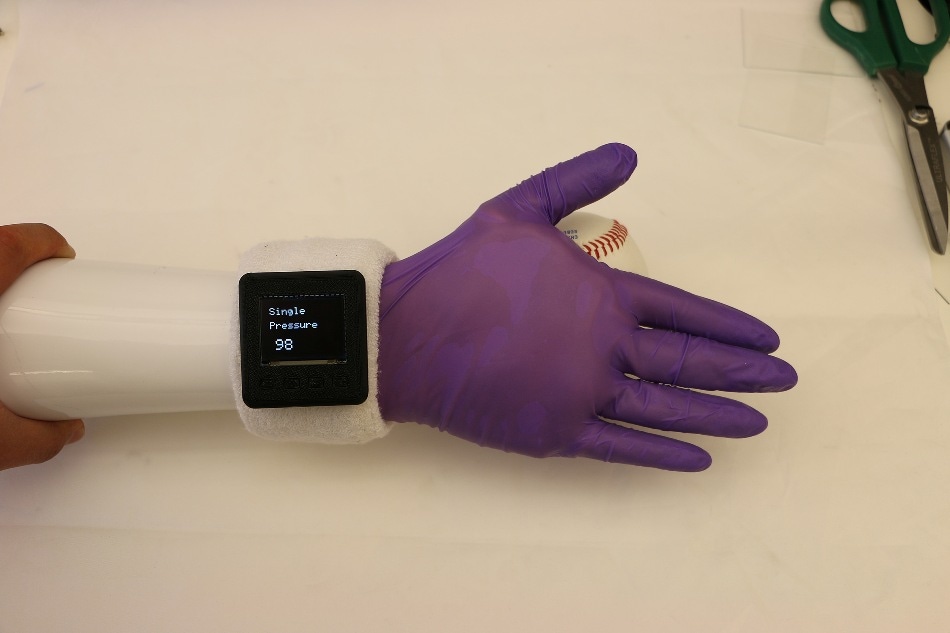Sep 5 2019
Individuals with hand amputations tend to go through difficult challenges in their day-to-day life, which usually result in permanent use of prosthetic services and prosthetic hands.
 An electronic glove, or e-glove, developed by Purdue University researchers can be worn over a prosthetic hand to provide humanlike softness, warmth, appearance, and sensory perception. (Image credit: Purdue University/Chris Adam)
An electronic glove, or e-glove, developed by Purdue University researchers can be worn over a prosthetic hand to provide humanlike softness, warmth, appearance, and sensory perception. (Image credit: Purdue University/Chris Adam)
Now, researchers at Purdue University have developed an electronic glove, or e-glove, that can be worn over a prosthetic hand to give appearance, warmth, softness, and sensory perception just like humans. For example, the e-glove offers the potential to sense hydration, temperature, and pressure.
The innovative technology has been reported in the August 30th, 2019, edition of NPG Asia Materials.
Typically, a traditional prosthetic hand helps in restoring mobility, but the latest e-glove has advanced this technology by providing true human-like features in life roles and everyday activities of prosthetic hand users. This offers the possibility to enhance the well-being and mental health of such users by aiding them to more naturally incorporate the e-glove into social settings.
Thin and flexible electronic sensors as well as tiny silicon-based circuit chips on the commercial nitrile glove are used by the e-glove. When linked to an exclusively developed wristwatch, the e-glove enables a real-time display of sensory data that is remotely transmitted to the user to process it at a later time.
In order to develop the e-glove technology, Chi Hwan Lee, an assistant professor in the College of Engineering of Purdue University, collaborated with other scientists at Purdue University, the University of Texas, and the University of Georgia.
We developed a novel concept of the soft-packaged, sensor-instrumented e-glove built on a commercial nitrile glove, allowing it to seamlessly fit on arbitrary hand shapes. The e-glove is configured with a stretchable form of multimodal sensors to collect various information such as pressure, temperature, humidity and electrophysiological biosignals, while simultaneously providing realistic human hand-like softness, appearance and even warmth.
Chi Hwan Lee, Assistant Professor, College of Engineering, Purdue University
Lee and his group believe that the capabilities and appearance of the novel e-glove will enhance the well-being of prosthetic hand users by enabling them to feel more at ease in social settings. The e-glove has artificial fingernails, has lifelike fingerprints, and comes in different skin tone colors.
“The prospective end-user could be any prosthetic hand users who have felt uncomfortable wearing current prosthetic hands, especially in many social contexts,” stated Lee.
The e-glove can be fabricated cost-effectively and manufactured at large scale, making it a low-cost option for users. This makes it different from other emerging technologies that have muscle, mind, and voice control integrated inside the prosthetic at an exorbitant cost. In addition, such emerging technologies cannot offer the human-like features provided by the e-glove.
Lee, together with Min Ku Kim, an engineering doctoral student at Purdue University and study co-author, worked with the Purdue Research Foundation Office of Technology Commercialization to patent the novel technology.
The researchers are looking for partners to team up in clinical trials or specialists in the prosthetics domain to verify the use of the e-glove to further improve its design.
My group is devoted to developing various wearable biomedical devices, and my ultimate goal is to bring these technologies out of the lab and help many people in need. This research represents my continued efforts in this context.
Chi Hwan Lee, Assistant Professor, College of Engineering, Purdue University
The study aligns with Purdue University’s Giant Leaps commemoration of the university’s worldwide developments in health as part of its 150th anniversary. That is one among the four themes of the yearlong celebration’s Ideas Festival, created to demonstrate Purdue University as an intellectual hub that solves real-world problems.
Electronic glove offers ‘humanlike’ features for prosthetic hand users
Sensor-instrumented glove for prosthetic hand controls has the ability to sense pressure, temperature, and hydration using electronic chips sending sensory data through wristwatch. (Video credit: Purdue University)